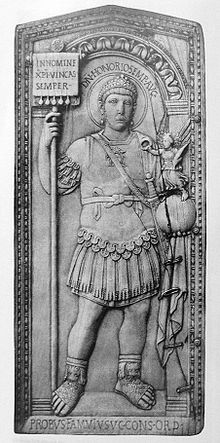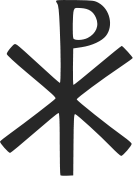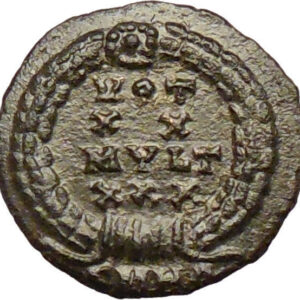|
Arcadius
–
Roman Emperor
: 383-408 A.D. –
Bronze AE3 18mm (4.18 grams) Struck circa 395-401 A.D.
DNARCADIVSPFAVG – Pearl diademed, draped and cuirassed bust right.
VIRTVSEXERCITI – Arcadius standing, facing, holding labarum and
resting hand on shield;
being crowned by
Victory
to right, holding wreath.
You are bidding on the exact item pictured,
provided with a Certificate of Authenticity and Lifetime Guarantee of
Authenticity.

Labarum of Constantine I, displaying the “Chi-Rho” symbol above.
The labarum was a
vexillum
(military standard) that displayed
the “Chi-Rho”
symbol
☧
, formed from the first two
Greek letters
of the word “Christ”
—
Chi
and
Rho
. It was first used by the
Roman emperor
Constantine I
. Since the vexillum consisted of
a flag suspended from the crossbar of a cross, it was ideally suited to
symbolize the
crucifixion
of
Christ
.
Later usage has sometimes regarded the terms “labarum” and “Chi-Rho” as
synonyms. Ancient sources, however, draw an unambiguous distinction between the
two.
Etymology
Beyond its derivation from Latin labarum, the etymology of the word is
unclear. Some derive it from Latin /labāre/ ‘to totter, to waver’ (in the sense
of the “waving” of a flag in the breeze) or laureum [vexillum] (“laurel
standard”). According to the
Real Academia Española
, the related
lábaro
is also derived from Latin labărum
but offers no further derivation from within Latin, as does the Oxford English
Dictionary.[5]
An origin as a loan into Latin from a Celtic language or
Basque
has also been postulated. There is a
traditional Basque symbol called the
lauburu
; though the name is only attested from
the 19th century onwards the motif occurs in engravings dating as early as the
2nd century AD.
Vision of Constantine

A coin of Constantine (c.337) showing a depiction of his labarum
spearing a serpent.
On the evening of October 27, 312, with his army preparing for the
Battle of the Milvian Bridge
, the emperor
Constantine I
claimed to have had a vision
which led him to believe he was fighting under the protection of the
Christian God
.
Lactantius
states that, in the night before the
battle, Constantine was commanded in a dream to “delineate the heavenly sign on
the shields of his soldiers”. He obeyed and marked the shields with a sign
“denoting Christ”. Lactantius describes that sign as a “staurogram”, or a
Latin cross
with its upper end rounded in a
P-like fashion, rather than the better known
Chi-Rho
sign described by
Eusebius of Caesarea
. Thus, it had both the
form of a cross and the monogram of Christ’s name from the formed letters “X”
and “P”, the first letters of Christ’s name in Greek.
From Eusebius, two accounts of a battle survive. The first, shorter one in
the
Ecclesiastical History
leaves no doubt that
God helped Constantine but doesn’t mention any vision. In his later Life of
Constantine, Eusebius gives a detailed account of a vision and stresses that
he had heard the story from the emperor himself. According to this version,
Constantine with his army was marching somewhere (Eusebius doesn’t specify the
actual location of the event, but it clearly isn’t in the camp at Rome) when he
looked up to the sun and saw a cross of light above it, and with it the Greek
words
Ἐν Τούτῳ Νίκα
. The traditionally employed
Latin translation of the Greek is
in hoc signo vinces
— literally “In this
sign, you will conquer.” However, a direct translation from the original Greek
text of Eusebius into English gives the phrase “By this, conquer!”
At first he was unsure of the meaning of the apparition, but the following
night he had a dream in which Christ explained to him that he should use the
sign against his enemies. Eusebius then continues to describe the labarum, the
military standard used by Constantine in his later wars against
Licinius
, showing the Chi-Rho sign.
Those two accounts can hardly be reconciled with each other, though they have
been merged in popular notion into Constantine seeing the Chi-Rho sign on the
evening before the battle. Both authors agree that the sign was not readily
understandable as denoting Christ, which corresponds with the fact that there is
no certain evidence of the use of the letters chi and rho as a Christian sign
before Constantine. Its first appearance is on a Constantinian silver coin from
c. 317, which proves that Constantine did use the sign at that time, though not
very prominently. He made extensive use of the Chi-Rho and the labarum only
later in the conflict with Licinius.
The vision has been interpreted in a solar context (e.g. as a
solar halo
phenomenon), which would have been
reshaped to fit with the Christian beliefs of the later Constantine.
An alternate explanation of the intersecting celestial symbol has been
advanced by George Latura, which claims that Plato’s visible god in Timaeus
is in fact the intersection of the Milky Way and the Zodiacal Light, a rare
apparition important to pagan beliefs that Christian bishops reinvented as a
Christian symbol.
Eusebius’ description of the labarum
“A Description of the Standard of the Cross, which the Romans now call the
Labarum.” “Now it was made in the following manner. A long spear, overlaid with
gold, formed the figure of the cross by means of a transverse bar laid over it.
On the top of the whole was fixed a wreath of gold and precious stones; and
within this, the symbol of the Saviour’s name, two letters indicating the name
of Christ by means of its initial characters, the letter P being intersected by
X in its centre: and these letters the emperor was in the habit of wearing on
his helmet at a later period. From the cross-bar of the spear was suspended a
cloth, a royal piece, covered with a profuse embroidery of most brilliant
precious stones; and which, being also richly interlaced with gold, presented an
indescribable degree of beauty to the beholder. This banner was of a square
form, and the upright staff, whose lower section was of great length, of the
pious emperor and his children on its upper part, beneath the trophy of the
cross, and immediately above the embroidered banner.”
“The emperor constantly made use of this sign of salvation as a safeguard
against every adverse and hostile power, and commanded that others similar to it
should be carried at the head of all his armies.”
Iconographic career under Constantine

Coin of
Vetranio
, a soldier is holding two
labara. Interestingly they differ from the labarum of Constantine in
having the Chi-Rho depicted on the cloth rather than above it, and
in having their staves decorated with
phalerae
as were earlier Roman
military unit standards.

The emperor
Honorius
holding a variant of the
labarum – the Latin phrase on the cloth means “In the name of Christ
[rendered by the Greek letters XPI] be ever victorious.”
Among a number of standards depicted on the
Arch of Constantine
, which was erected, largely
with fragments from older monuments, just three years after the battle, the
labarum does not appear. A grand opportunity for just the kind of political
propaganda that the Arch otherwise was expressly built to present was missed.
That is if Eusebius’ oath-confirmed account of Constantine’s sudden,
vision-induced, conversion can be trusted. Many historians have argued that in
the early years after the battle the emperor had not yet decided to give clear
public support to Christianity, whether from a lack of personal faith or because
of fear of religious friction. The arch’s inscription does say that the Emperor
had saved the
res publica
INSTINCTV DIVINITATIS
MENTIS MAGNITVDINE (“by greatness of mind and by instinct [or impulse]
of divinity”). As with his predecessors, sun symbolism – interpreted as
representing
Sol Invictus
(the Unconquered Sun) or
Helios
,
Apollo
or
Mithras
– is inscribed on his coinage, but in
325 and thereafter the coinage ceases to be explicitly pagan, and Sol Invictus
disappears. In his
Historia Ecclesiae
Eusebius further reports
that, after his victorious entry into Rome, Constantine had a statue of himself
erected, “holding the sign of the Savior [the cross] in his right hand.” There
are no other reports to confirm such a monument.
Whether Constantine was the first
Christian
emperor supporting a peaceful
transition to Christianity during his rule, or an undecided pagan believer until
middle age, strongly influenced in his political-religious decisions by his
Christian mother
St. Helena
, is still in dispute among
historians.
As for the labarum itself, there is little evidence for its use before 317.In
the course of Constantine’s second war against Licinius in 324, the latter
developed a superstitious dread of Constantine’s standard. During the attack of
Constantine’s troops at the
Battle of Adrianople
the guard of the labarum
standard were directed to move it to any part of the field where his soldiers
seemed to be faltering. The appearance of this talismanic object appeared to
embolden Constantine’s troops and dismay those of Licinius.At the final battle
of the war, the
Battle of Chrysopolis
, Licinius, though
prominently displaying the images of Rome’s pagan pantheon on his own battle
line, forbade his troops from actively attacking the labarum, or even looking at
it directly.[16]
Constantine felt that both Licinius and
Arius
were agents of Satan, and associated them
with the serpent described in the
Book of Revelation
(12:9).
Constantine represented Licinius as a snake on his coins.
Eusebius stated that in addition to the singular labarum of Constantine,
other similar standards (labara) were issued to the Roman army. This is
confirmed by the two labara depicted being held by a soldier on a coin of
Vetranio
(illustrated) dating from 350.
Later usage

Modern ecclesiastical labara (Southern Germany).

The emperor
Constantine Monomachos
(centre
panel of a Byzantine enamelled crown) holding a miniature labarum
The Chi Rho is one of the earliest
christograms
used by Christians. It is formed by superimposing the
first two letters in the Greek spelling of the word
Christ
(
Greek
: “Χριστός” ), chi = ch and rho = r, in such a way to produce
the monogram
☧. The Chi-Rho symbol was also used by pagan Greek scribes to
mark, in the margin, a particularly valuable or relevant passage; the relevant passage; the
combined
letters Chi and Rho standing for chrēston, meaning “good.” Although not technically a cross, the Chi Rho invokes the crucifixion
of Jesus as well as symbolizing his status as the Christ. There is early
evidence of the Chi Rho symbol on Christian Rings of the third century.
The labarum (Greek:
λάβαρον) was a
vexillum
(military standard) that displayed the “Chi-Rho”
symbol, formed from the first two
Greek letters
of the word “Christ”
(Greek:
ΧΡΙΣΤΟΣ, or Χριστός) — Chi (χ)
and Rho (ρ).
It was first used by the
Roman emperor
Constantine I
. Since the vexillum consisted of a flag suspended from
the crossbar of a cross, it was ideally suited to symbolize
crucifixion
. The Chi-Rho symbol was also used by Greek scribes to
mark, in the margin, a particularly valuable or relevant passage; the
combined letters Chi and Rho standing for chrēston, meaning
“good.”
In
Roman mythology
, Victoria was the personification/Goddess of victory.
She is the Roman version of the
Greek goddess
Nike
, and was associated with
Bellona
. She was adapted from the
Sabine
agricultural goddess
Vacuna
and had
a
temple
on the
Palatine Hill
. Her name (in Latin) means victory. Unlike the Greek Nike, Victoria (Latin
for “victory”) was a major part of Roman society. Multiple temples were erected
in her honour. When her statue was removed in 382 AD by emperor
Gratianus
there was much anger in Rome. She was normally worshipped by
triumphant
generals returning from war. Also unlike the Greek Nike, who was known for success in athletic games such
as chariot races, Victoria was a symbol of victory over death and determined who
would be successful during war. Appearing on Roman coins, jewelry, architecture, and other arts, Victoria is
often seen with or in a
chariot
. An
example of this is her place upon the
Brandenburg Gate
in Berlin, Germany.
Flavius
Arcadius (377/378–1 May 408) was
Byzantine Emperor
in the Eastern half of the
Roman
Empire
from 395 until his death.
//
Arcadius was born in
Hispania
,
the elder son of
Theodosius I
and
Aelia Flaccilla
, and brother of
Honorius
, who would become a
Western Roman Emperor
. His father declared him an
Augustus
and co-ruler for the
Eastern half of the Empire
in January, 383. His younger brother was also
declared Augustus in 393, for the Western half.
As emperors, Honorius was under the control of the Romanized
Vandal
magister militum
Flavius
Stilicho
while Arcadius was dominated by one of his ministers,
Rufinus
. Stilicho is alleged by some to have wanted control of both
emperors, and is supposed to have had Rufinus assassinated by Gothic mercenaries
in 395; though definite proof of Stilicho’s involvement in the assassination is
lacking, the intense competition and political jealousies engendered by the two
figures compose the main thread of the first part of Arcadius’ reign. Arcadius’
new advisor, the eunuch
Eutropius
, simply took Rufinus’ place as the power behind the Eastern
imperial throne.
Arcadius was also dominated by his wife
Aelia
Eudoxia
, who convinced her husband to dismiss Eutropius, who was holding the
consulate, at the height of his power, in 399. That same year, on the 13th July,
Arcadius issued an edict ordering that
all remaining non-Christian temples should be immediately demolished
.
Eudoxia’s influence was strongly opposed by
John Chrysostom
, the
Patriarch of Constantinople
, who felt that she had used her family’s wealth
to gain control over the emperor. Eudoxia used her influence to have Chrysostom
deposed in 404, but she died later that year. Eudoxia gave to Arcadius four
children: three daughters,
Pulcheria
,
Arcadia and Marina, and one son, Theodosius, the future Emperor
Theodosius II
.
Arcadius was dominated for the rest of his rule by
Anthemius
, the
Praetorian Prefect
, who made peace with Stilicho in the West. Arcadius
himself was more concerned with appearing to be a pious
Christian
than he was with political or military matters, and he died, only
nominally in control of his empire, in 408.
Character and works
In this reign of a weak emperor dominated by court politics,
a major theme was the ambivalence felt by prominent individuals and the court
parties that formed and regrouped round them towards
barbarians
,
which in Constantinople at this period meant
Goths
. In the
well-documented episode that revolved around
Gainas
, a
number of Gothic foederati stationed in the capital were massacred, the
survivors fleeing under the command of Gainas to
Thrace
, where
they were tracked down by imperial troops and slaughtered and Gainas dispatched.
The episode has been traditionally interpreted as a paroxysm of anti-barbarian
reaction that served to stabilise the East. The main source for the affair is a
mythology à clef by
Synesius
of
Cyrene, Aegyptus sive de providentia, (400)
an Egyptianising allegory that embodies a covert account of the events, the
exact interpretation of which continues to baffle scholars. Synesius’ De
regno, which claims to be addressed to Arcadius himself, contains a tirade
against Goths.
A new
forum
was built in the name of Arcadius, on the seventh hill of
Constantinople, the Xērolophos, in which a
column
was begun to commemorate his ‘victory’ over Gainas (although the
column was only completed after Arcadius’ death by
Theodosius II
).
The
Pentelic marble
portrait head of Arcadius (illustration) was
discovered in Istanbul close to the Forum Tauri, in June 1949, in excavating
foundations for new buildings of the University at
Beyazit
.
The neck was designed to be inserted in a torso, but no statue, base or
inscription was found. The
diadem
is a
fillet with rows of pearls along its edges and a rectangular stone set about
with pearls over the young emperor’s forehead.
|















